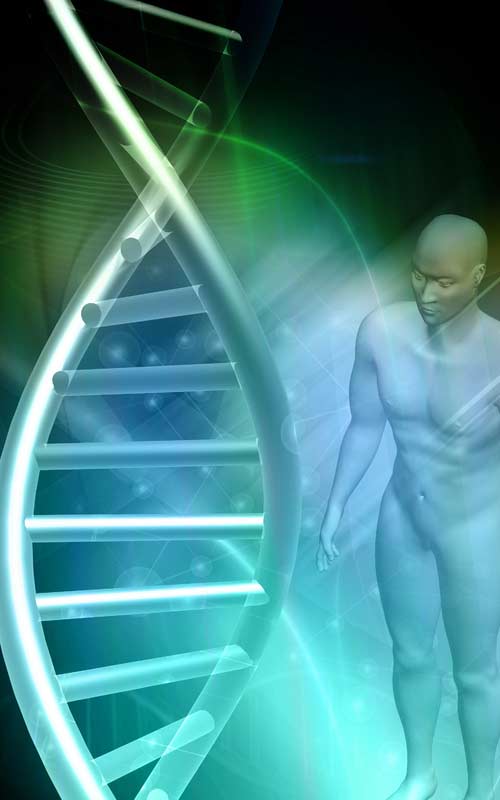Epigenetics: A Revolutionary Look at How Humans Work

Scientists are now pinpointing exactly how nurture affects nature. Life experiences — from toxin exposure to physical affection — can alter gene expression in dynamic and sometimes reversible ways. These insights — the result of a burgeoning field called epigenetics — were aided by the sequencing of the human genome, completed in 2003. However, the genome itself turns out to have limited value for understanding disease and human characteristics. Most traits and diseases involve a multitude of gene combinations, and while "you can identify certain associated genes, they don't explain that much," said Dennis Grayson, a researcher at the University of Illinois at Chicago. But the epigenome may provide countless explanations. The most surprising thing about this revolutionary field, Grayson said, is that no one is talking about it yet. The real boss It is now common knowledge that humans share the majority of their genes with monkeys and apes, even worms and mice. It is something called the epigenome that keeps us from "having a long tail and a snout," said Randy Jirtle, an epigenetics research pioneer at Duke University in North Carolina. Epigenome literally means "above the genome." It is a molecular marking system that controls gene expression without altering the DNA sequence. In a sense, the epigenome is the genome's boss. In the initial weeks after an egg is fertilized — when its cells are rapidly multiplying and developing into something like a full-fledged body — the epigenome acts as an overbearing micro-manager. Each new cell has identical DNA, but the epigenome orders some cells to work as, say, skin cells and others to become neurons. New view It was once thought this nitpicking backed off after birth, except for a brief resurgence around puberty. But recently scientists have realized the boss is always watching —taking stock of not only the genome but the world at large. "The fascinating thing about it is that the epigenome is the mediator between the genes and the environment," said Liang Liu, a researcher at the University of Alabama at Birmingham Food, pollution, toxic chemicals (such as those found in hard clear plastics), drugs, stress, even exercise and social interaction can all affect the epigenome and alter its attitude towards DNA, Liu said. Sometimes, the epigenome responds to environmental cues by asking a gene, via a charged molecular messenger, either to start working or to work harder. For example, experiments by Michael Meaney and colleagues at McGill University have shown that when rat mothers are affectionate to their young, the baby’s epigenome promotes a gene that helps the pup remain calm even in stressful situations. (Conversely, neglected rat pups grow up observably anxious.) Other times, the epigenome demotes a gene. Many cancers, in fact, involve an irrational epigenetic firing of the gene that fights off tumors. The delivery of a molecular pink slip — often a methyl group — to the gene spurs a tight recoiling of the DNA spiral. The contraction makes it harder, or impossible, for transcription factors to interact with the gene — like stripping an employee of her Blackberry, computer and contact list. Wishy-washy The epigenome, however, is occasionally a wishy-washy supervisor. In some cases, epigenomic "decisions" can be reversed, Jirtle said. Many medical treatments, Grayson said, such as those being developed for cancer and schizophrenia, try to coax the epigenome into changing its mind. Similarly, healthy nutrition and lifestyle choices can positively sway gene expression. "Food is truly medicine when you are talking about epigenetic changes," Jirtle said. Even interpersonal relationships can persuade the epigenome to have a change of heart. For example, when neglected rat babies were adopted by affectionate mothers, the talented stress response gene was put back to work. And the pups calmed down. The epigenome’s malleability highlights the power we can have over the health of ourselves and our children, said Jirtle. And gives hope that complicated diseases will someday have cures.
- You Decide: What's the Greatest Mystery in Science?
- Top 10 Worst Hereditary Diseases
- All About DNA and Genes
Get the world’s most fascinating discoveries delivered straight to your inbox.
Robin Nixon is a former staff writer for Live Science. Robin graduated from Columbia University with a BA in Neuroscience and Behavior and pursued a PhD in Neural Science from New York University before shifting gears to travel and write. She worked in Indonesia, Cambodia, Jordan, Iraq and Sudan, for companies doing development work before returning to the U.S. and taking journalism classes at Harvard. She worked as a health and science journalist covering breakthroughs in neuroscience, medicine, and psychology for the lay public, and is the author of "Allergy-Free Kids; The Science-based Approach To Preventing Food Allergies," (Harper Collins, 2017). She will attend the Yale Writer’s Workshop in summer 2023.



